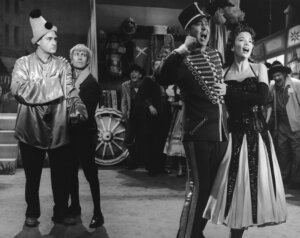‘He was not even a Jew or a person; he was a force’ — Sid Caesar at 100
Born in Yonkers in 1922, the creator of ‘Your Show of Shows’ was part pugilist, part comic

A portrait of Sid Caesar, circa 1986 Photo by Getty Images
The centenary of American Jewish comedian Sid Caesar, who was born Sept. 8, 1922, is a good occasion to look back and see how Yiddishkeit influenced his artistry. Some of his oldest friends and colleagues, like Mel Brooks, whom he employed as a writer, discounted the Jewish aspect of his comic spirit. During a February 2014 appearance on Conan O’Brien’s talk show, Brooks declared that Caesar “was not even a Jew or a person; he was a force.”
Caesar himself explained the absence of explicit Jewish characters or sustained references in his shows to The Jewish Chronicle in October 2010. He “didn’t want to make fun of being Jewish,” he said. He turned down the ultra-Jewish role of Al Jolson in a 1946 biopic. And he demurred when a Jewish Telegraphic Agency interviewer tried in 2000 to link his humor to his family roots, snapping that it was entirely possible to “be Jewish and be bad” at comedy.
His audiences too were largely unaware that this strapping muscular jokester could be Jewish, according to historian Karen J. Harvey. Apparently they were accustomed to more diminutive Semitic comics. M. Avrum Ehrlich’s Encyclopedia of the Jewish Diaspora concurred that Caesar played many foreign characters, but “none of them specifically Jewish.” Literary critic Norman Simms even likened Caesar to the Marranos in his onscreen discretion about his origins.
And yet, his legendary 1950s programs “Your Show of Shows” and “Caesar’s Hour” inevitably echoed Jewish humor insofar as Caesar employed such writers as Brooks, Neil Simon, Larry Gelbart, Carl Reiner, Selma Diamond and Woody Allen, among others. Far more than injecting an occasional Yiddish term, Caesar’s comedy exuded omnivorous cultural preoccupations.
“We were just a bunch of very gifted, neurotic young Jews punching our brains out,” Gelbart told Time Magazine in 2000. This pugilistic competition occurred through rival erudition, Gelbart claimed: “Between us we read every book. Between us we saw every movie. Between us we saw every play on Broadway. You could make jokes about Kafka or Tennessee Williams.”
They ventured off-Broadway too, where in 1953 Caesar and Brooks attended a performance of “The World of Sholem Aleichem,” an adaptation by Arnold Perl of Yiddish short stories starring Jack Gilford, Morris Carnovsky and others. Caesar clearly felt at home among landsmen, and he was among the celebrity guest contributors to the zany Yiddishkeit of Al Feldstein’s Mad Magazine.

A feature in the September 1959 issue of Mad on a Professor Rumblemacher was attributed to Caesar, although it was more likely penned by one of his writers. After all, as American Jewish Year Book 2020 pointed out, Caesar’s show and Mad Magazine were the two U.S. mass media venues where Yiddishisms could be encountered in the 1950s.
With his employees regularly attending screenings of arty foreign films at New York’s Museum of Modern Art, near where his live shows were filmed, Caesar honed his ability to mimic rhythms of foreign languages. He was also assisted by his musician’s ear and the ability to insert just enough English words to be comprehensible to audiences. He claimed to have started doing this at his parents’ humble luncheonette in Yonkers. His father, Max Ziser, altered the family name at some point; a legend that it had been changed by an Ellis Island official has since been debunked.
Caesar was not objectively better at multilingual shtick than Carl Reiner or Howard Morris, his partners in many such routines. Yet Caesar’s passionate violence surpassed the more controlled, wry artistry of his colleagues. Despite this accomplished spiel, his art was not essentially verbal, as the Americanist Stephen J. Whitfield has observed.
For Caesar, as he often remarked, language was a form of music. And he was a gifted saxophonist, playing in the Borscht Belt and briefly with the bands of Shep Fields (born Saul Feldman) and Benny Goodman. In a 1954 broadcast, Caesar soloed with the usually frozen-hearted Goodman’s ensemble. Caesar naturally appears taxed under the circumstances, but managed a performance encapsulating intense ire. Caesar’s powerful expressivity in jazz reflects the rages he inflicted on others in his circle, about which there was nothing amusing for the recipients, not even when recalled decades later.
The brute force that is part of Caesar’s ongoing fascination paradoxically may have to do with the fact that he wasn’t kidding in his performances, any more than was his performance partner, Imogene Coca, an earnest Giulietta Masina-like presence in sketches mocking films and other artworks.

From the first episode of “Your Show of Shows,” featuring the opera baritone Robert Merrill (born Moishe Miller in Williamsburg) the presence of high culture was a basis for Caesar’s comedy. Neurotic young Jews punching their brains out in the 1950s were drawn to opera, and a 1955 televised parody of Leoncavallo’s “Pagliacci” is considered a career highlight.
Modeling their work after Metropolitan Opera performances by tenor Richard Tucker (born Rivn Ticker in Brooklyn), Merrill and another American baritone of Jewish origin, Leonard Warren (born Warenoff), Caesar’s troupe excelled, especially Carl Reiner, a wannabe opera baritone who had studied classical voice.
The resulting riot packs a wallop, as does another sketch, “Argument to Beethoven’s Fifth,” in which a married couple, played by Caesar and Nanette Fabray, gesticulate while an excerpt from the symphony is played. At a time when Jewish music lovers could hear radio performances of Beethoven’s Fifth conducted by Bruno Walter, Leonard Bernstein, and other Jewish maestros, Caesar and his writers remind us how culture was once part of American mass media discourse.
Elsewhere, Caesar’s evocations of American popular culture could resemble the grotesque tragicomedies of author Nathanael West (born Nathan Weinstein). One example was “Aggravation Boulevard,” something like the screen musical “Singin’ in the Rain” on acid. A silent screen heartthrob with a ludicrously high voice is played with heartbreaking intensity by Caesar.
One of Caesar’s most Jewish traits as a comedian, in addition to his omnivorous cultural appetite, was his insistence on feeling rachmones for even his most absurd characters, rendering them human and empathetic. While his television and stage stardom collapsed due to a quarter-century of alcohol and barbiturate abuse, Caesar never fully realized his potential in Hollywood, likely being attached to live audiences. In Stanley Kramer’s ponderous, strident 1963 comedy “It’s a Mad, Mad, Mad, Mad World,” Caesar projects a macho persona, like a wary pugilist. Worse, in an alarming 1985 exercise video, “Sid Caesar’s Shape Up!,” he is an unwittingly ominous motivational speaker about physical fitness, but resembles a mafia capo who has spent long years in federal detention.
Throughout these high and low points, Caesar maintained a sense of camaraderie with fellow Jewish comedians, religiously attending a weekly get-together at Factor’s Famous Deli in Los Angeles during his later years. For all his foibles, Caesar’s greatness was always acknowledged by those near him. Neil Simon’s 1993 autobiographical play “Laughter on the 23rd Floor” about working for Caesar, describes the latter as a “giant. He’s Goliath. Maybe he’s Goliath after David hit him in the head with a rock.” Even if at times he was slightly damaged goods as a Jewish comedic hero, Caesar’s stature remains fully evident to everyone in his centenary year.

















